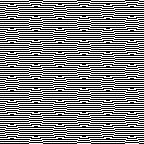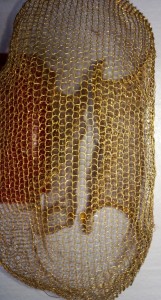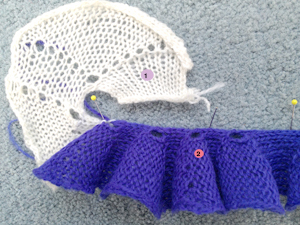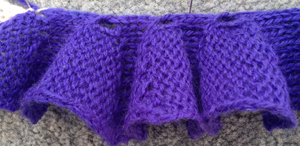One double-bed example, the Brother 900 E DB changer for use on both standard and bulky
The Studio/singer YC6 may be used either on the single or double bed simply by repositioning one piece. It includes a 4 color tension unit, a special sinker plate, and a set of cards that are for use only for DBJ. It has a 4-button yarn changer, which can be set for automatic 2-color changing.
Brother/Knitking comes with a supplementary two-color yarn mast, a special sinker plate, and a four-button changer. A button must be pressed manually for each color change.
To color change on Studio, the next color button is pushed/selected when the KC is on the right, in Brother machines, the button for the next color selection is pushed after the KC is in the yarn changing area after the audible “click” is produced when the carriage has traveled far enough.
The wires and tension units exert more tension on the yarn than standard tension units, which affects gauge so if one is knitting garments, the units should not be changed while working on the same piece, nor should calculations for gauge be used if they were produced in the same yarn, but using the alternate tension unit. Tension may have to be raised by at least one number or more to prevent dropped stitches and obtain the desired feel/drape.
If a carriage jam occurs, the sinker plate needs to be removed before using the release lever for KC.
If using changers for fair isle: in cards punched for FI knitting single bed, normally the contrast color, corresponding to punchcard holes (black squares on mylar, or pixels, depending on machine and programming) is placed in the B sinker plate feeder, and background yarn in the A.
When using the color changer, the manuals will state that the main color is normally in B while the contrast color is in A, where it can be changed automatically. However, that depends on which part of the design is to include the color striping. If it is to occur in the motif, the card needs to be modified by being punched in reverse. If the striping is to occur in the background, a standard card and position may be used. If one wishes to alternate, both ground and motif may need to be punched separately as for use in 2 color slip stitch.
More than 2 colors per row require color separations of the original design for knitting with slip stitch setting, carrying one color at a time, in 2-row sequences.
The double bed color changer is used often for DBJ with color-separated cards though other fabric options are possible. It may also be used for single bed work, but the ribber must remain raised and the ribber connecting plate is used. This means that single-bed fair isle knitting is not possible, because there is only one feeder in the ribber connecting plate.
Using the changer is a viable option for knitting striped patterns on bulky machines. There are no brushes to help anchor the knitting like the ones in the single bed sinker plate, so even though the fabrics may be worked only on the top bed, careful choosing of repeat and adequate weighting is required ie in color tuck/slip mosaics, etc, knit with color changes every 2 rows.
I have read that Toyota did not have a color changer due to its built-in simulknit/automatic DBJ, with only 2 colors knit in any one row.
Sometimes metal parts/wires get bent in storage or handling even on ribber sinker plate, and may need a bit of bending and tweaking if colors are not getting properly picked up. Some Brother color changers have small adjustment screws under the arm that may loosen, and change their alignment to the needle bed, which is easily solved by adjusting/tightening the screw. Sinker plates should be cleaned and may be adjusted if required, just like the standard ones.
Some references: Studio YC6, Brother manuals
The set up as described in an early Brother Fashion magazine

 from the KRC 900 manual
from the KRC 900 manual
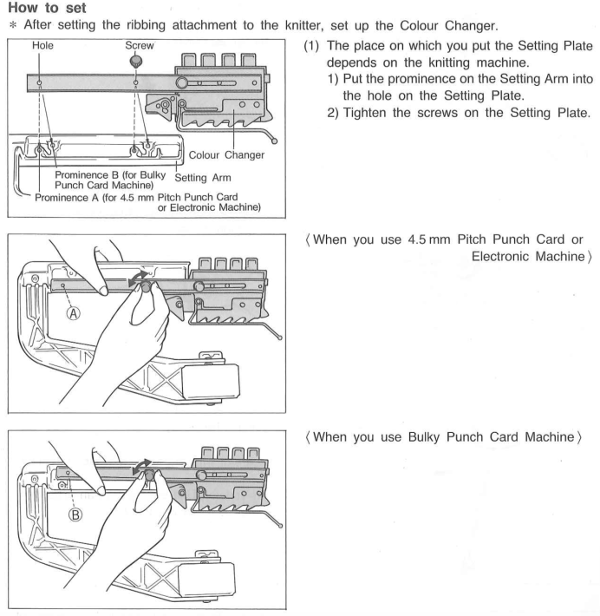
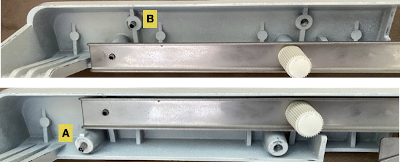
High tech version: 1 set up 2 in use Automatic knitting system based on the Brother KH-970, consisting of a knitting machine Brother KH-970, set for the ribbing attachment KR-850, KE-100 motor drive, and automatic color changer KRC-1000E (6 color changer). 
The Brother single bed changers are the only ones I know of where the yarn remains in the changer after the color change, never leaving it.
A later post including some single bed color changer info: https://alessandrina.com/2017/05/01/knitting-in-pattern-with-2-carriages-brother-punchcard-kms-2/.
Excerpts from the 820 manual: 
 The auxiliary yarn tension stand was eliminated when later models introduced a place in the machine casing for the extra mast, my 930 actually offers 2 spots
The auxiliary yarn tension stand was eliminated when later models introduced a place in the machine casing for the extra mast, my 930 actually offers 2 spots 


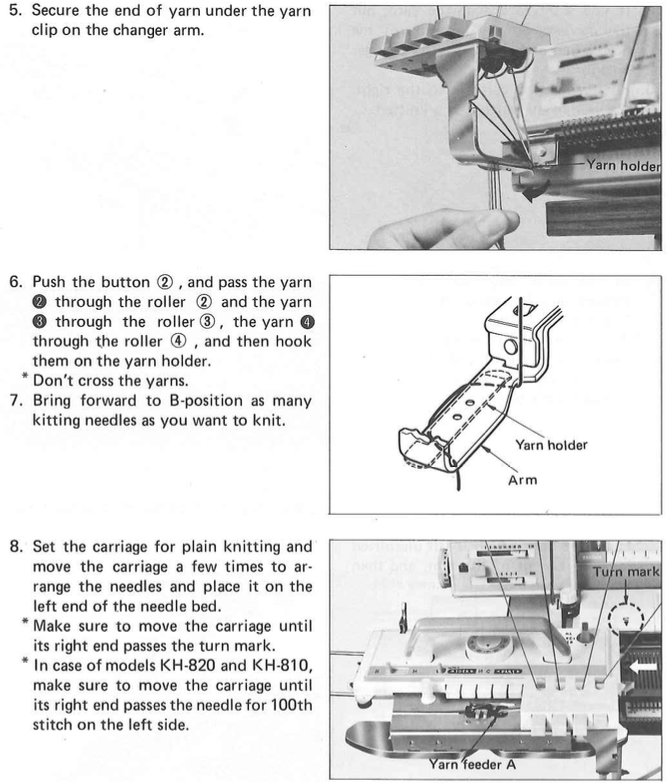 It is possible to cast on while the color changer sinker plate is in use, making certain the yarn is used and retained in its proper placement in its roller. I prefer to cast on with the standard sinker plate, knit some rows, weigh the piece, sort the required tension, place the yarn in its position in the changer with COR, and then continue.
It is possible to cast on while the color changer sinker plate is in use, making certain the yarn is used and retained in its proper placement in its roller. I prefer to cast on with the standard sinker plate, knit some rows, weigh the piece, sort the required tension, place the yarn in its position in the changer with COR, and then continue.
It is always a good idea to test color-changing sequences on some waste yarn rows prior to the permanent cast-on of the finished piece.
A common cause of color-changer crankiness is simply not moving far enough to the left before changing colors, a step that definitely requires using that “lace” extension rail.
The use of waste knitting is shown in the directions found in the manual as well.
An added difference between brands, the Studio changer uses letters, and the Brother uses numbers for yarn positions in changers 
 At the opposite end of the spectrum, the image below shows a low-tech “color changer” marketed beginning decades ago, and still available online. It is not practical to use in DBJ knitting because of the issues involved with removing the yarn from the ribber sinker arm in order to switch colors but can be an alternative for working single-bed on multiple gauge machines. It provides a way of holding the yarns that is easier and more successful than some of the other “creative” options for knitters who do not yet own a color changer accessory appropriate for their machine.
At the opposite end of the spectrum, the image below shows a low-tech “color changer” marketed beginning decades ago, and still available online. It is not practical to use in DBJ knitting because of the issues involved with removing the yarn from the ribber sinker arm in order to switch colors but can be an alternative for working single-bed on multiple gauge machines. It provides a way of holding the yarns that is easier and more successful than some of the other “creative” options for knitters who do not yet own a color changer accessory appropriate for their machine. 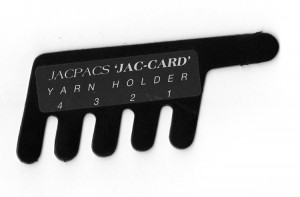 An improvised “color changer” for knitting multiple color dbj by Chris Burdge, shared in the Ayab FB group.
An improvised “color changer” for knitting multiple color dbj by Chris Burdge, shared in the Ayab FB group.
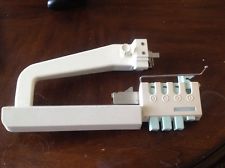



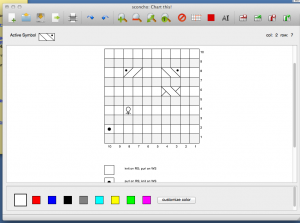




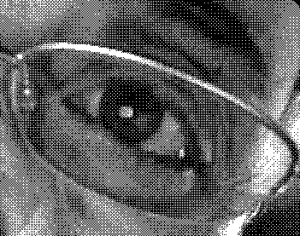



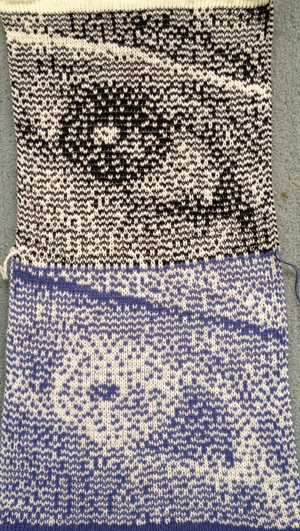
 May 24, 2019 a greyscale mode scaled image processed in
May 24, 2019 a greyscale mode scaled image processed in 
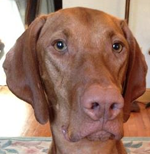
 The image is used with the kind permission of Rocco’s owner. I have used this image before, when I posted previously on some ways to reduce colored images to B/W for possible knitting using a Mac computer, please see post on 013/03/14/ color-reduction- conversions-mac-os/. Gimp offers some alternatives to the familiar dithers and is available, free, for both PC and Mac platforms. Tutorial links on Gimp edge detection available online as of May 2019 are listed at bottom of the post.
The image is used with the kind permission of Rocco’s owner. I have used this image before, when I posted previously on some ways to reduce colored images to B/W for possible knitting using a Mac computer, please see post on 013/03/14/ color-reduction- conversions-mac-os/. Gimp offers some alternatives to the familiar dithers and is available, free, for both PC and Mac platforms. Tutorial links on Gimp edge detection available online as of May 2019 are listed at bottom of the post.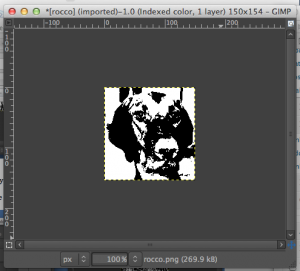
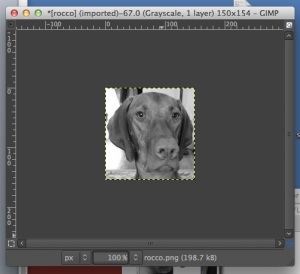


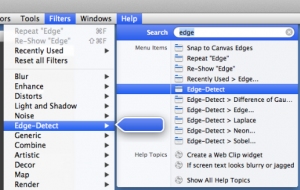 Difference of Gaussians
Difference of Gaussians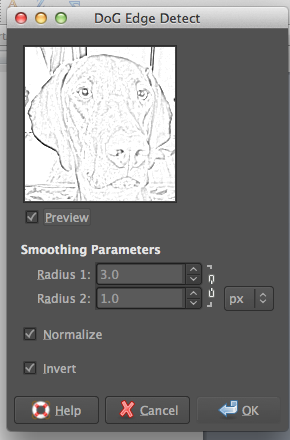
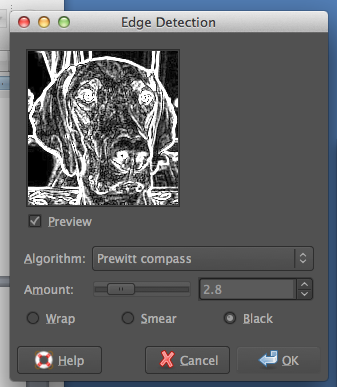
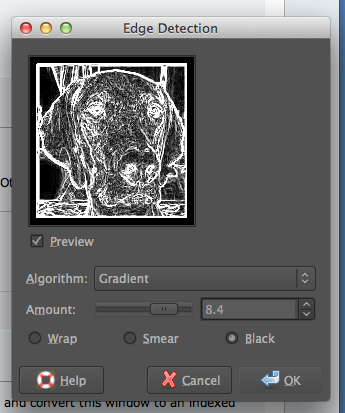


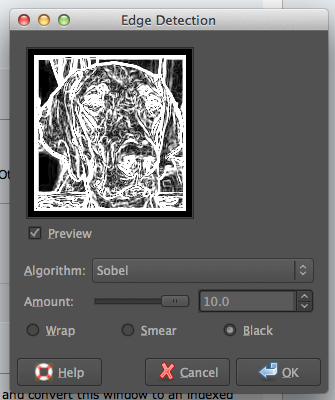

 adjusting B/W with Threshold
adjusting B/W with Threshold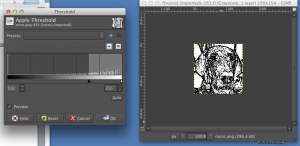 after a bit of “tweaking”
after a bit of “tweaking” 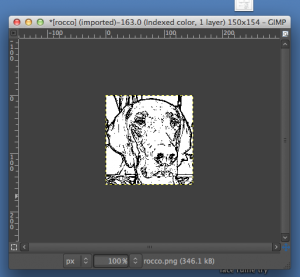 Image_Mode_Indexed, rendering it “knittable in 2 colors”
Image_Mode_Indexed, rendering it “knittable in 2 colors” 
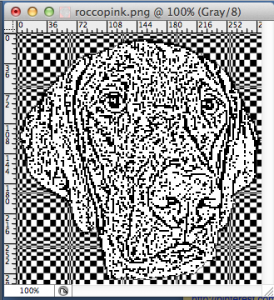
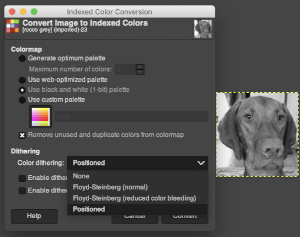






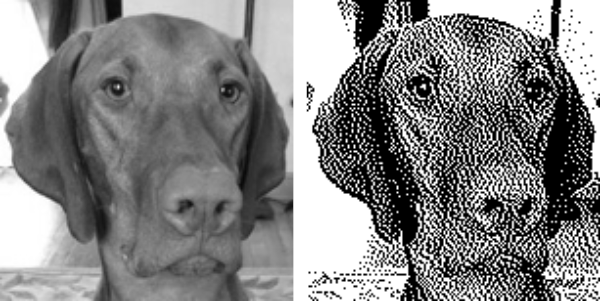 default Stucki
default Stucki

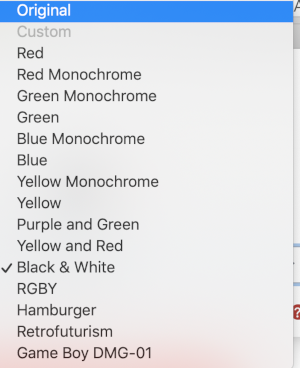
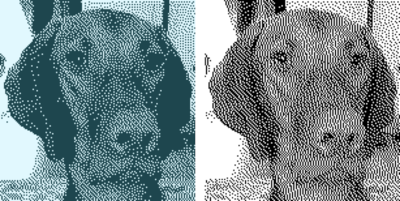

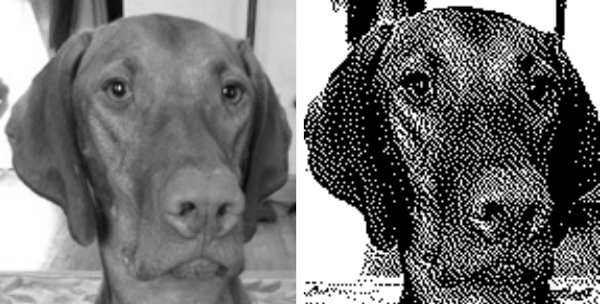 Check dithered results, downloaded images may be in RGB Mode. Prior to any knitting, they will need to be converted to B/W indexed.
Check dithered results, downloaded images may be in RGB Mode. Prior to any knitting, they will need to be converted to B/W indexed. imported the result into Gimp and saved it in indexed 2 color BW and in turn, 3 color indexed mode, no color adjustments, finding the result pleasantly simple
imported the result into Gimp and saved it in indexed 2 color BW and in turn, 3 color indexed mode, no color adjustments, finding the result pleasantly simple 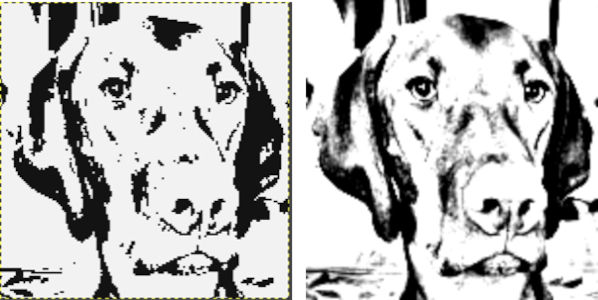 beginning with the greyscale generated image followed by Mode changes in Gimp, indexed 2 color BW, then indexed 3 color, there appear to be very subtle differences with a bit more detail:
beginning with the greyscale generated image followed by Mode changes in Gimp, indexed 2 color BW, then indexed 3 color, there appear to be very subtle differences with a bit more detail: 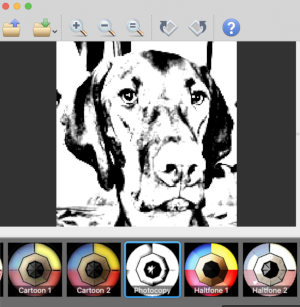
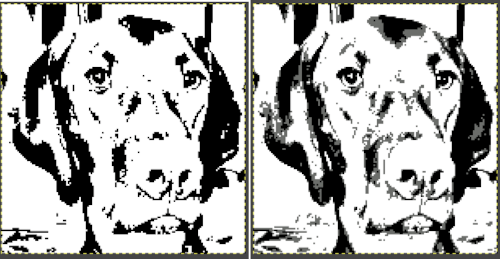
 It is possible to reduce images to 4 or 3 colors using the program as well: a slider for color count is used to choose the final number of colors in the reduction. Again, these instances have no added manipulation
It is possible to reduce images to 4 or 3 colors using the program as well: a slider for color count is used to choose the final number of colors in the reduction. Again, these instances have no added manipulation 
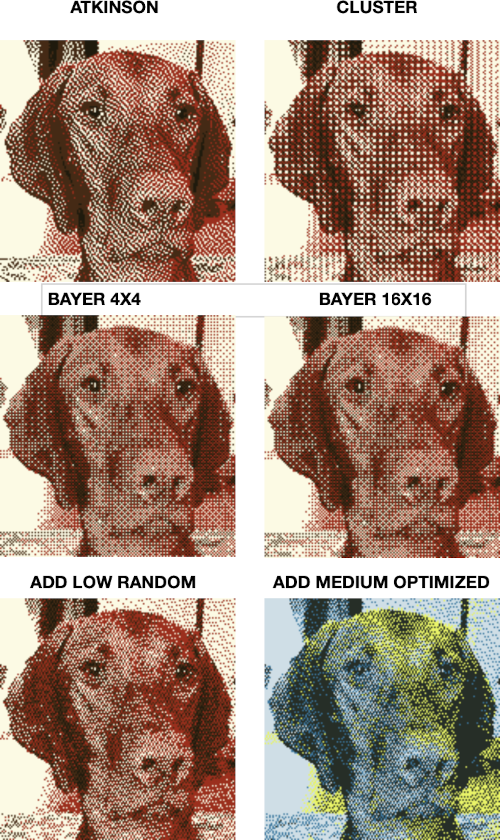 To retain the quality and size of the dithered image, download it, rather than using a screen grab. The software used to separate the chosen dither may alter the result somewhat. I am writing my posts using an iMac M1 with OS 12.0.1. At this point Ayab is not operable, img2track does open images, but in this case, with interesting distortions, and it does not download any files at all.
To retain the quality and size of the dithered image, download it, rather than using a screen grab. The software used to separate the chosen dither may alter the result somewhat. I am writing my posts using an iMac M1 with OS 12.0.1. At this point Ayab is not operable, img2track does open images, but in this case, with interesting distortions, and it does not download any files at all.  Yet another dithering
Yet another dithering 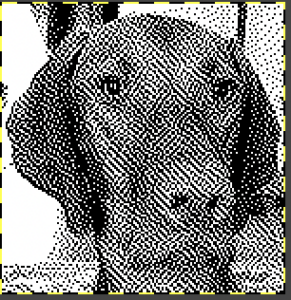



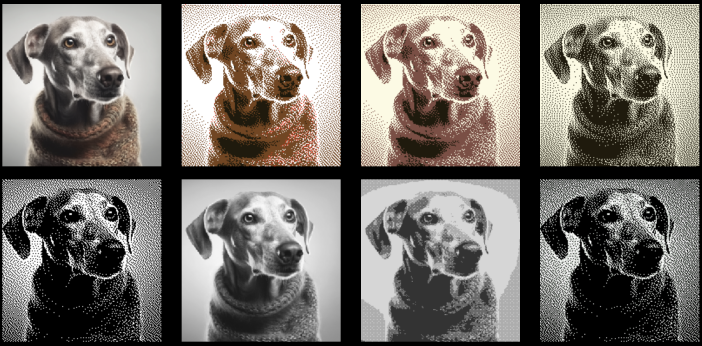
 On odd-numbered rows beginning with row 1, mark all empty squares in the even-numbered light-colored row immediately above it with purl symbols.
On odd-numbered rows beginning with row 1, mark all empty squares in the even-numbered light-colored row immediately above it with purl symbols.  All unmarked stitches throughout the design are knit, whether, on the “wrong/right” sides, all dashes are purled, patterning occurs on the second row of each color. To visualize the full pattern one may use the add row below feature to expand the graph (the chart below is missing the very first row).
All unmarked stitches throughout the design are knit, whether, on the “wrong/right” sides, all dashes are purled, patterning occurs on the second row of each color. To visualize the full pattern one may use the add row below feature to expand the graph (the chart below is missing the very first row).  Now add the second row of each color and grounding stripe (s) at bottom of the repeat. Most patterns will start the illusion immediately after casting on with dark color, row 1 above. I was interested in my sample having a border of sorts on its top and bottom.
Now add the second row of each color and grounding stripe (s) at bottom of the repeat. Most patterns will start the illusion immediately after casting on with dark color, row 1 above. I was interested in my sample having a border of sorts on its top and bottom. 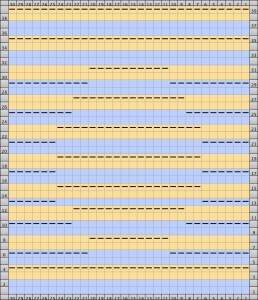 The resulting knit swatch
The resulting knit swatch 
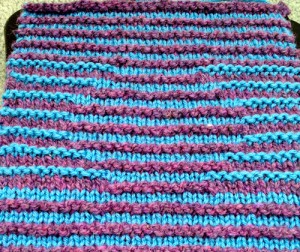
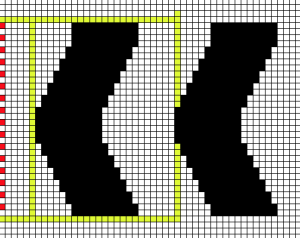 the actual repeat
the actual repeat  color inversion begins on row 1 and follows every other row (if numbered these would be odd rows)
color inversion begins on row 1 and follows every other row (if numbered these would be odd rows)  testing the repeat through filter/ map/ tile
testing the repeat through filter/ map/ tile  a working chart that can be printed to suit with dark/light row markings and blank squares for tracking knitting rows in the execution of the pattern
a working chart that can be printed to suit with dark/light row markings and blank squares for tracking knitting rows in the execution of the pattern  A larger version with stitch and row counts marked. The chart represents half the rows in the actual knit. The cast on row counts as knit row 1, color 1, and following the chart beginning with row 2 knit the black squares and purl the white squares. *Change color, knit one row (odd#), on the next row follow the chart, knitting the black squares and purling the white (even#).** Repeat from * to **.
A larger version with stitch and row counts marked. The chart represents half the rows in the actual knit. The cast on row counts as knit row 1, color 1, and following the chart beginning with row 2 knit the black squares and purl the white squares. *Change color, knit one row (odd#), on the next row follow the chart, knitting the black squares and purling the white (even#).** Repeat from * to **.  the knit swatch: “shadow side”
the knit swatch: “shadow side” 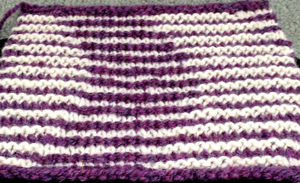
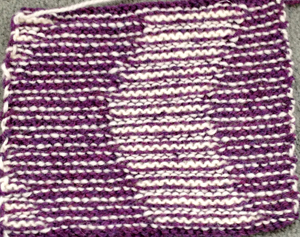
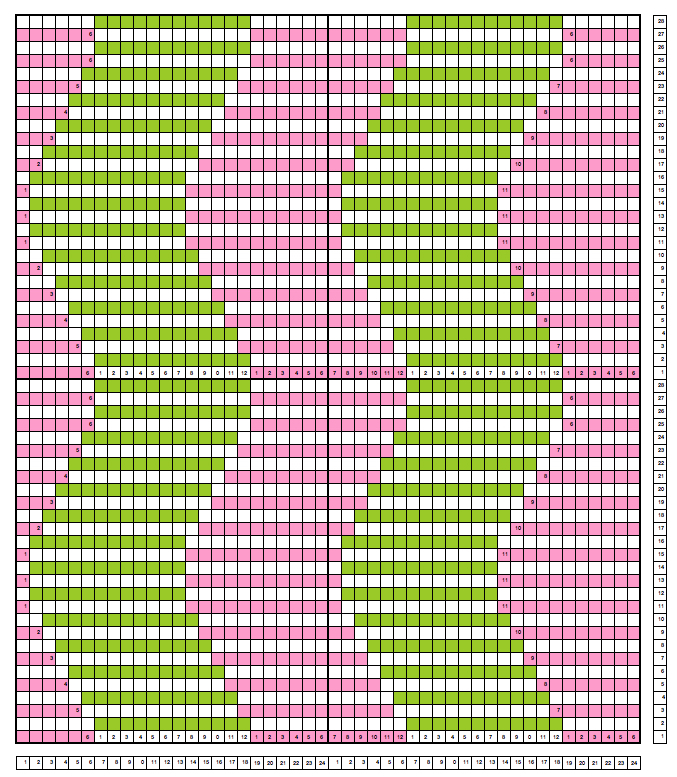 Follow up:
Follow up: 
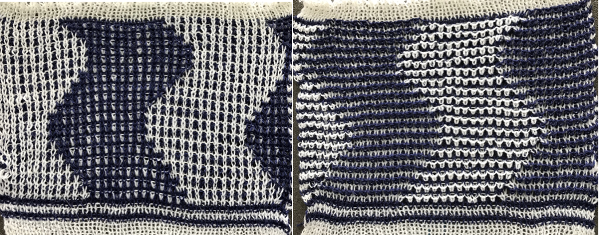



 a 24X24 repeat
a 24X24 repeat 

